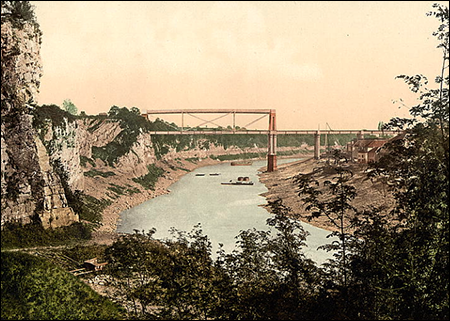Chepstow railway station
Chepstow station dates from the opening in 1850 of the South Wales Railway, which ran from Chepstow to Swansea and was engineered by Isambard Kingdom Brunel. The railway builders were the first people to breach the town’s medieval port wall.
Brunel’s design for station buildings along the Great Western Railway from London to Bristol featured an Italianate hipped roof which generously overhung the walls. The South Wales Railway used the same basic design. The station building at Chepstow is usually ascribed to GWR engineer Lancaster Owen. However, he was born in 1843.
A smaller building in similar style was provided at Chepstow, on the platform used by westbound trains. It was demolished sometime after 1962.
In 1872 Brunel’s broad gauge tracks (2.14 metres between the rails) were replaced with standard gauge (1.44 metres). Four years later, the station became busier with the opening of the Wye Valley Railway to Monmouth. Passengers complained about the gap between trains and platforms at Chepstow. The platforms were raised and in 1877 Chepstow contractor CW Whalley jacked up the station building, which weighed c.150 tons, by 56cm.
 The wooden building left the station entrance was once the parcels department. Goods wagons were loaded or unloaded in the stone building, said to be of Brunel’s design, which is now part of the builders’ yard outside the station. The footbridge, a listed structure, was built by local company Finch & Co., later Fairfield Mabey.
The wooden building left the station entrance was once the parcels department. Goods wagons were loaded or unloaded in the stone building, said to be of Brunel’s design, which is now part of the builders’ yard outside the station. The footbridge, a listed structure, was built by local company Finch & Co., later Fairfield Mabey.
Brunel’s railway bridge over the river Wye at Chepstow was a novel tubular bridge, replaced in 1962 (Brunel’s piers remain). It is pictured here in the 1890s. It was the precursor of his larger Royal Albert Bridge, near Plymouth. Brunel had previously helped Robert Stephenson with the Conwy tubular bridge, and his adaptation of the principles at Chepstow almost halved construction costs.
Chepstow was bypassed in 1886 with the opening of the Severn Tunnel, which provided a more direct route between Cardiff and London. Chepstow station now provides access to the starting points of the Wales Coast Path and Offa’s Dyke Path, with trains from various places including Cardiff, Birmingham and Nottingham.
With thanks to Henry Hodges, of The Chepstow Society
Postcode: NP16 5PD View Location Map


